Road Traffic Accidents and ITS: A Logistics Perspective Report
VerifiedAdded on 2021/04/17
|45
|12532
|480
Report
AI Summary
This report provides a comprehensive analysis of road traffic accidents from a logistics and supply chain management perspective. It begins with a literature review discussing road traffic conditions, challenges, and accident overviews globally and in the UK. The report delves into the impacts of road traffic accidents on society and the economy, both globally and in the UK, followed by a discussion of strategies and policies adopted to manage these accidents. It explores Intelligent Transportation Systems (ITS) and their applications in mitigating road safety issues, including technological advancements and the benefits of ITS. The research methodology section outlines the research design, type, approaches, techniques, and limitations. The report concludes by summarizing key findings and providing references and appendices.
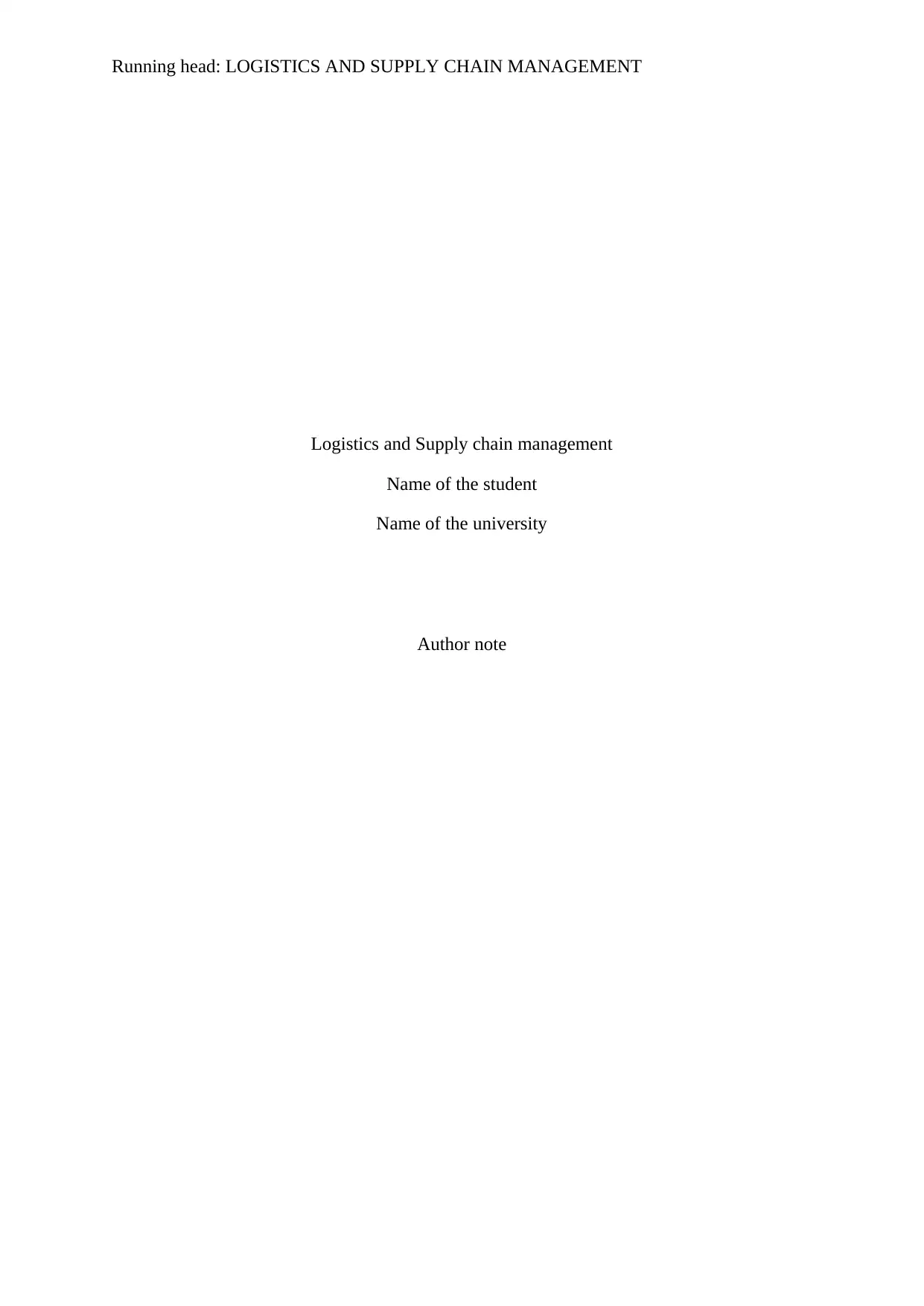
Running head: LOGISTICS AND SUPPLY CHAIN MANAGEMENT
Logistics and Supply chain management
Name of the student
Name of the university
Author note
Logistics and Supply chain management
Name of the student
Name of the university
Author note
Paraphrase This Document
Need a fresh take? Get an instant paraphrase of this document with our AI Paraphraser
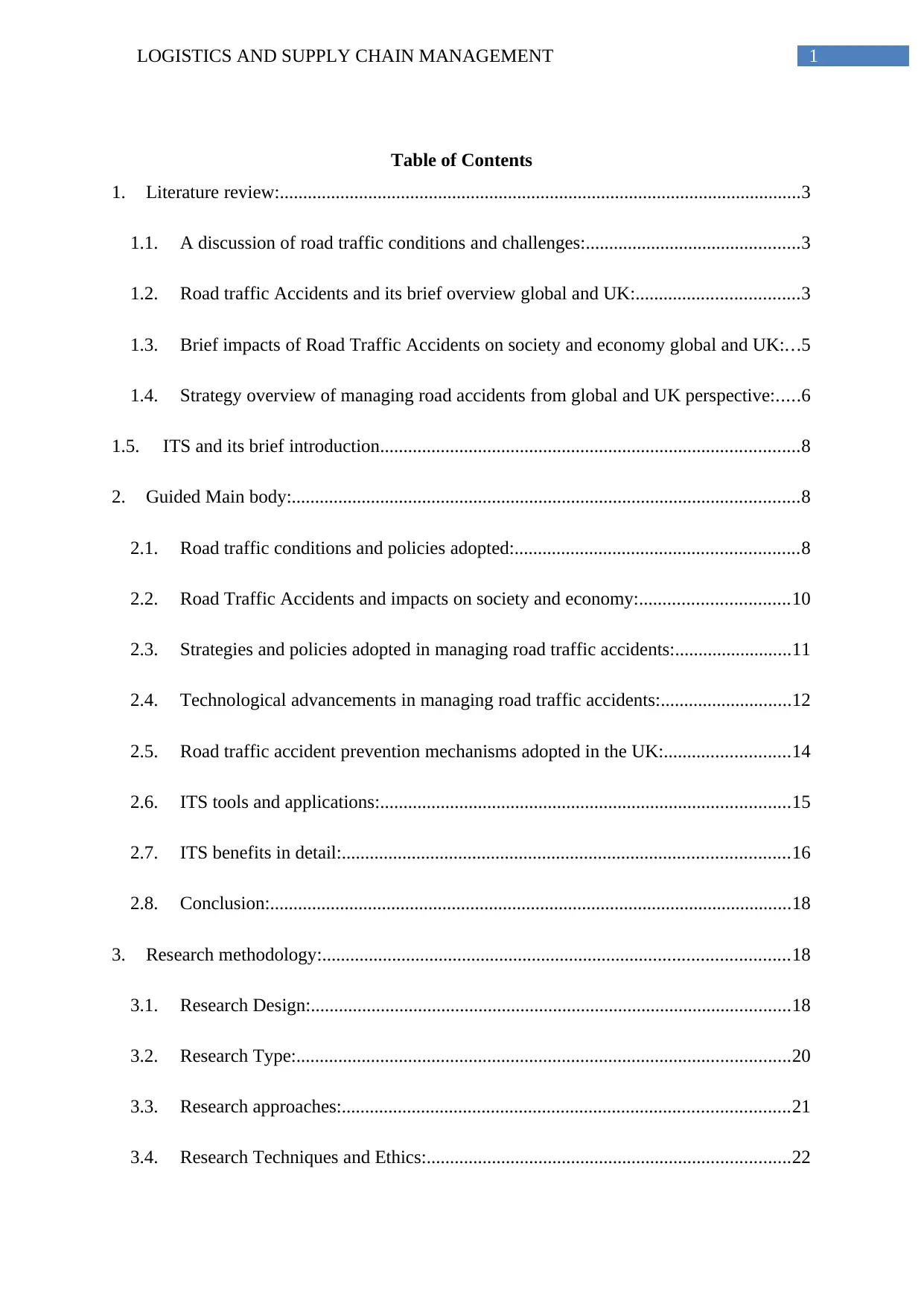
1LOGISTICS AND SUPPLY CHAIN MANAGEMENT
Table of Contents
1. Literature review:................................................................................................................3
1.1. A discussion of road traffic conditions and challenges:..............................................3
1.2. Road traffic Accidents and its brief overview global and UK:...................................3
1.3. Brief impacts of Road Traffic Accidents on society and economy global and UK:...5
1.4. Strategy overview of managing road accidents from global and UK perspective:.....6
1.5. ITS and its brief introduction..........................................................................................8
2. Guided Main body:.............................................................................................................8
2.1. Road traffic conditions and policies adopted:.............................................................8
2.2. Road Traffic Accidents and impacts on society and economy:................................10
2.3. Strategies and policies adopted in managing road traffic accidents:.........................11
2.4. Technological advancements in managing road traffic accidents:............................12
2.5. Road traffic accident prevention mechanisms adopted in the UK:...........................14
2.6. ITS tools and applications:........................................................................................15
2.7. ITS benefits in detail:................................................................................................16
2.8. Conclusion:................................................................................................................18
3. Research methodology:....................................................................................................18
3.1. Research Design:.......................................................................................................18
3.2. Research Type:..........................................................................................................20
3.3. Research approaches:................................................................................................21
3.4. Research Techniques and Ethics:..............................................................................22
Table of Contents
1. Literature review:................................................................................................................3
1.1. A discussion of road traffic conditions and challenges:..............................................3
1.2. Road traffic Accidents and its brief overview global and UK:...................................3
1.3. Brief impacts of Road Traffic Accidents on society and economy global and UK:...5
1.4. Strategy overview of managing road accidents from global and UK perspective:.....6
1.5. ITS and its brief introduction..........................................................................................8
2. Guided Main body:.............................................................................................................8
2.1. Road traffic conditions and policies adopted:.............................................................8
2.2. Road Traffic Accidents and impacts on society and economy:................................10
2.3. Strategies and policies adopted in managing road traffic accidents:.........................11
2.4. Technological advancements in managing road traffic accidents:............................12
2.5. Road traffic accident prevention mechanisms adopted in the UK:...........................14
2.6. ITS tools and applications:........................................................................................15
2.7. ITS benefits in detail:................................................................................................16
2.8. Conclusion:................................................................................................................18
3. Research methodology:....................................................................................................18
3.1. Research Design:.......................................................................................................18
3.2. Research Type:..........................................................................................................20
3.3. Research approaches:................................................................................................21
3.4. Research Techniques and Ethics:..............................................................................22
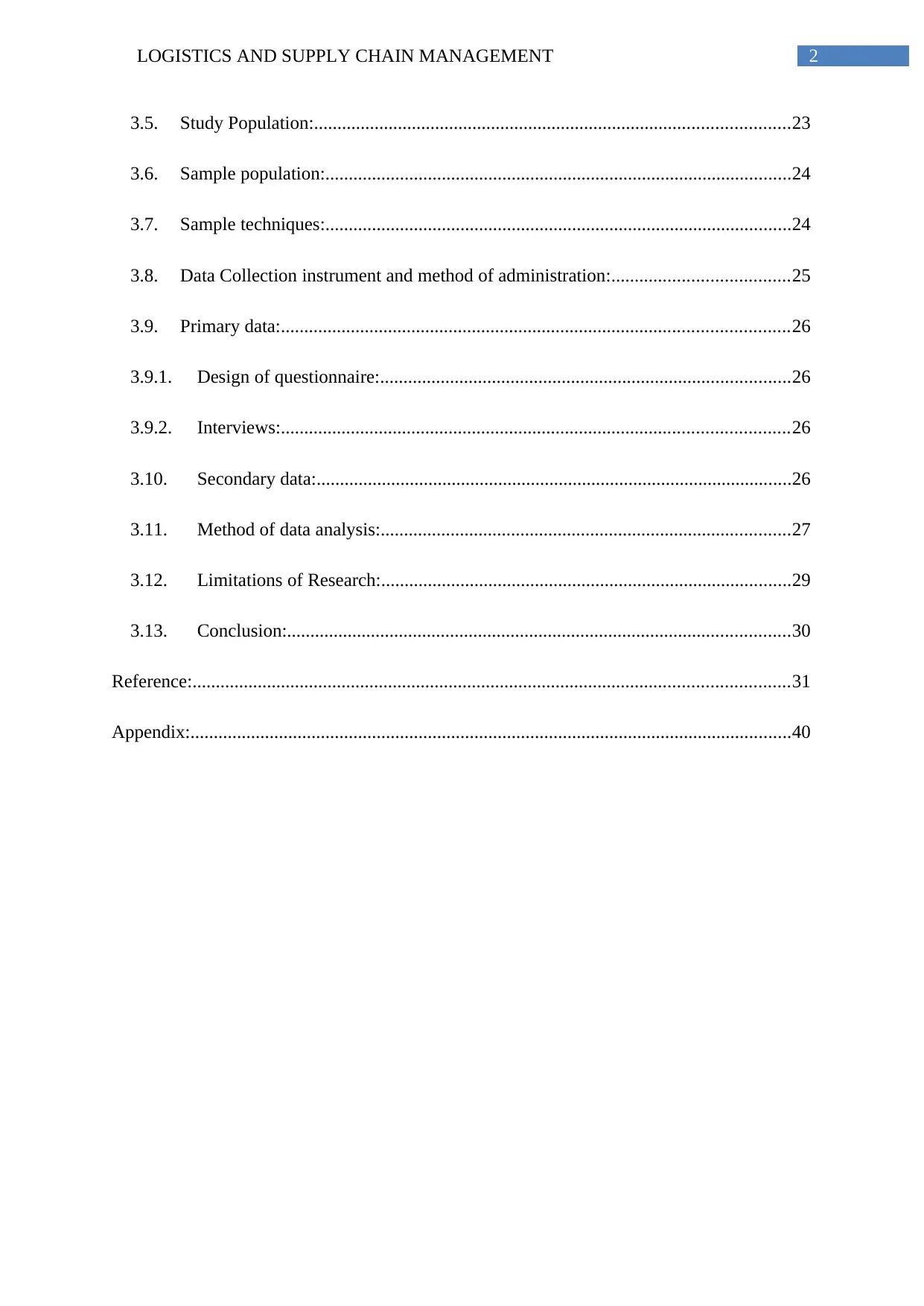
2LOGISTICS AND SUPPLY CHAIN MANAGEMENT
3.5. Study Population:......................................................................................................23
3.6. Sample population:....................................................................................................24
3.7. Sample techniques:....................................................................................................24
3.8. Data Collection instrument and method of administration:......................................25
3.9. Primary data:.............................................................................................................26
3.9.1. Design of questionnaire:........................................................................................26
3.9.2. Interviews:.............................................................................................................26
3.10. Secondary data:......................................................................................................26
3.11. Method of data analysis:........................................................................................27
3.12. Limitations of Research:........................................................................................29
3.13. Conclusion:............................................................................................................30
Reference:................................................................................................................................31
Appendix:.................................................................................................................................40
3.5. Study Population:......................................................................................................23
3.6. Sample population:....................................................................................................24
3.7. Sample techniques:....................................................................................................24
3.8. Data Collection instrument and method of administration:......................................25
3.9. Primary data:.............................................................................................................26
3.9.1. Design of questionnaire:........................................................................................26
3.9.2. Interviews:.............................................................................................................26
3.10. Secondary data:......................................................................................................26
3.11. Method of data analysis:........................................................................................27
3.12. Limitations of Research:........................................................................................29
3.13. Conclusion:............................................................................................................30
Reference:................................................................................................................................31
Appendix:.................................................................................................................................40
⊘ This is a preview!⊘
Do you want full access?
Subscribe today to unlock all pages.

Trusted by 1+ million students worldwide
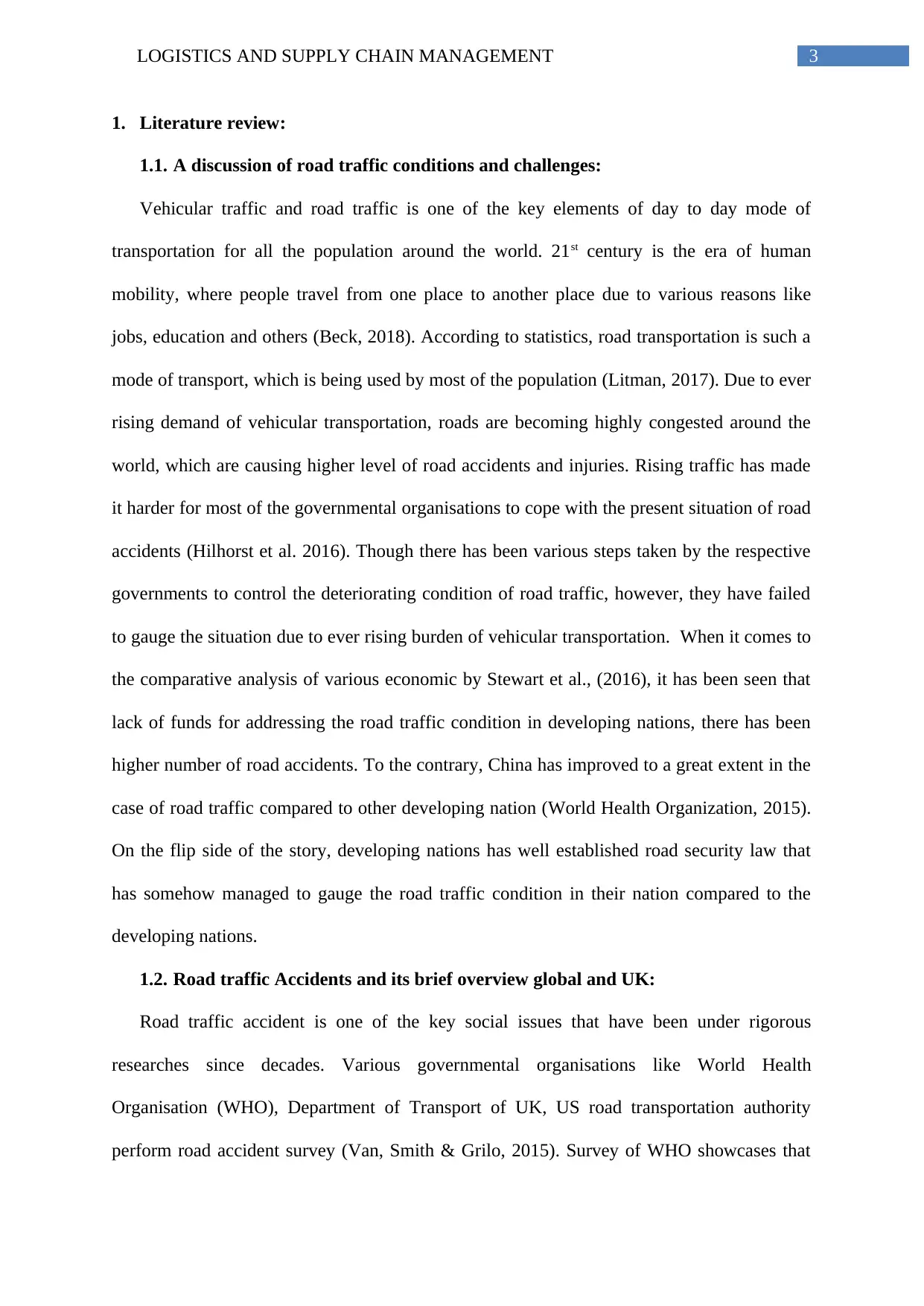
3LOGISTICS AND SUPPLY CHAIN MANAGEMENT
1. Literature review:
1.1. A discussion of road traffic conditions and challenges:
Vehicular traffic and road traffic is one of the key elements of day to day mode of
transportation for all the population around the world. 21st century is the era of human
mobility, where people travel from one place to another place due to various reasons like
jobs, education and others (Beck, 2018). According to statistics, road transportation is such a
mode of transport, which is being used by most of the population (Litman, 2017). Due to ever
rising demand of vehicular transportation, roads are becoming highly congested around the
world, which are causing higher level of road accidents and injuries. Rising traffic has made
it harder for most of the governmental organisations to cope with the present situation of road
accidents (Hilhorst et al. 2016). Though there has been various steps taken by the respective
governments to control the deteriorating condition of road traffic, however, they have failed
to gauge the situation due to ever rising burden of vehicular transportation. When it comes to
the comparative analysis of various economic by Stewart et al., (2016), it has been seen that
lack of funds for addressing the road traffic condition in developing nations, there has been
higher number of road accidents. To the contrary, China has improved to a great extent in the
case of road traffic compared to other developing nation (World Health Organization, 2015).
On the flip side of the story, developing nations has well established road security law that
has somehow managed to gauge the road traffic condition in their nation compared to the
developing nations.
1.2. Road traffic Accidents and its brief overview global and UK:
Road traffic accident is one of the key social issues that have been under rigorous
researches since decades. Various governmental organisations like World Health
Organisation (WHO), Department of Transport of UK, US road transportation authority
perform road accident survey (Van, Smith & Grilo, 2015). Survey of WHO showcases that
1. Literature review:
1.1. A discussion of road traffic conditions and challenges:
Vehicular traffic and road traffic is one of the key elements of day to day mode of
transportation for all the population around the world. 21st century is the era of human
mobility, where people travel from one place to another place due to various reasons like
jobs, education and others (Beck, 2018). According to statistics, road transportation is such a
mode of transport, which is being used by most of the population (Litman, 2017). Due to ever
rising demand of vehicular transportation, roads are becoming highly congested around the
world, which are causing higher level of road accidents and injuries. Rising traffic has made
it harder for most of the governmental organisations to cope with the present situation of road
accidents (Hilhorst et al. 2016). Though there has been various steps taken by the respective
governments to control the deteriorating condition of road traffic, however, they have failed
to gauge the situation due to ever rising burden of vehicular transportation. When it comes to
the comparative analysis of various economic by Stewart et al., (2016), it has been seen that
lack of funds for addressing the road traffic condition in developing nations, there has been
higher number of road accidents. To the contrary, China has improved to a great extent in the
case of road traffic compared to other developing nation (World Health Organization, 2015).
On the flip side of the story, developing nations has well established road security law that
has somehow managed to gauge the road traffic condition in their nation compared to the
developing nations.
1.2. Road traffic Accidents and its brief overview global and UK:
Road traffic accident is one of the key social issues that have been under rigorous
researches since decades. Various governmental organisations like World Health
Organisation (WHO), Department of Transport of UK, US road transportation authority
perform road accident survey (Van, Smith & Grilo, 2015). Survey of WHO showcases that
Paraphrase This Document
Need a fresh take? Get an instant paraphrase of this document with our AI Paraphraser
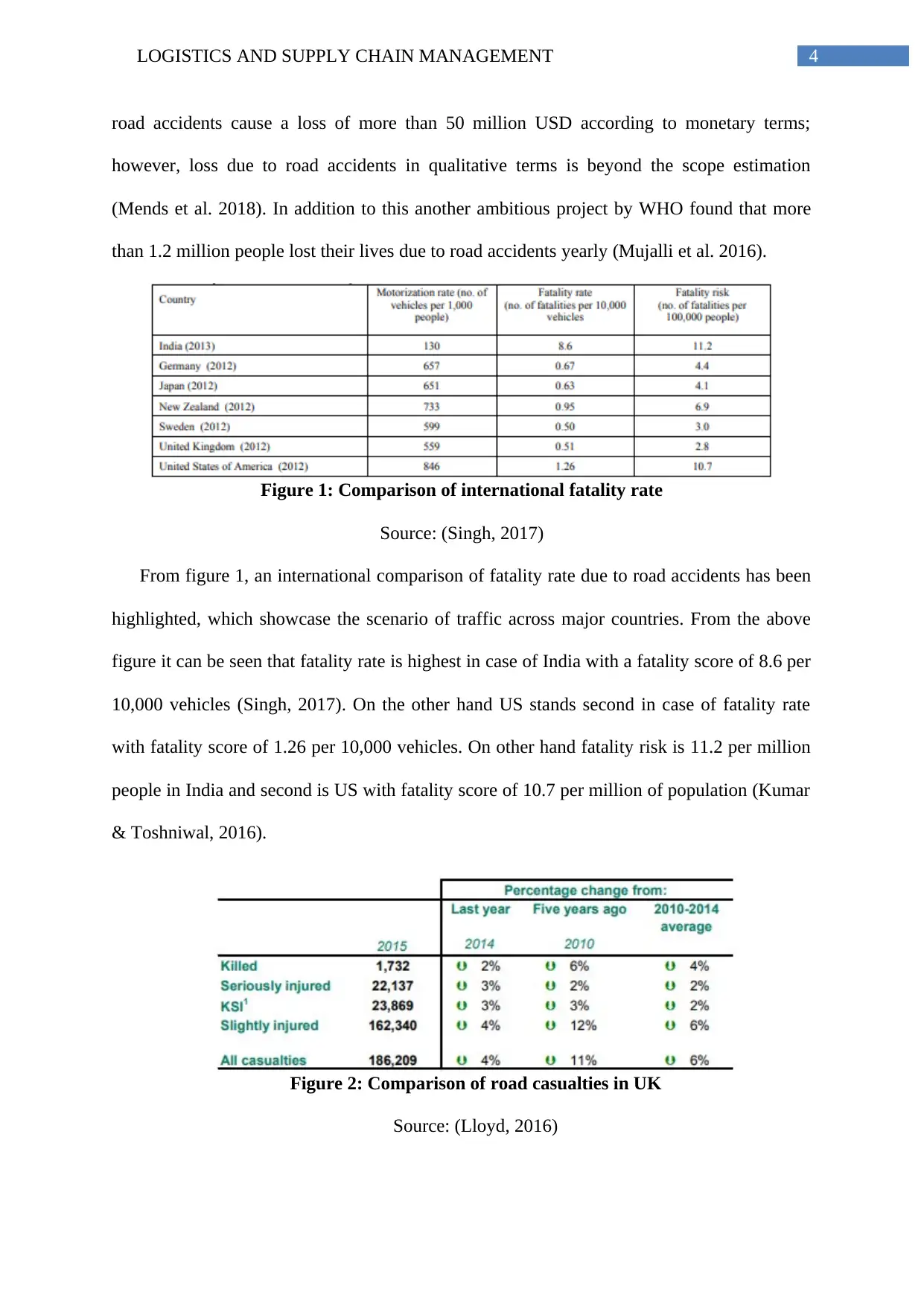
4LOGISTICS AND SUPPLY CHAIN MANAGEMENT
road accidents cause a loss of more than 50 million USD according to monetary terms;
however, loss due to road accidents in qualitative terms is beyond the scope estimation
(Mends et al. 2018). In addition to this another ambitious project by WHO found that more
than 1.2 million people lost their lives due to road accidents yearly (Mujalli et al. 2016).
Figure 1: Comparison of international fatality rate
Source: (Singh, 2017)
From figure 1, an international comparison of fatality rate due to road accidents has been
highlighted, which showcase the scenario of traffic across major countries. From the above
figure it can be seen that fatality rate is highest in case of India with a fatality score of 8.6 per
10,000 vehicles (Singh, 2017). On the other hand US stands second in case of fatality rate
with fatality score of 1.26 per 10,000 vehicles. On other hand fatality risk is 11.2 per million
people in India and second is US with fatality score of 10.7 per million of population (Kumar
& Toshniwal, 2016).
Figure 2: Comparison of road casualties in UK
Source: (Lloyd, 2016)
road accidents cause a loss of more than 50 million USD according to monetary terms;
however, loss due to road accidents in qualitative terms is beyond the scope estimation
(Mends et al. 2018). In addition to this another ambitious project by WHO found that more
than 1.2 million people lost their lives due to road accidents yearly (Mujalli et al. 2016).
Figure 1: Comparison of international fatality rate
Source: (Singh, 2017)
From figure 1, an international comparison of fatality rate due to road accidents has been
highlighted, which showcase the scenario of traffic across major countries. From the above
figure it can be seen that fatality rate is highest in case of India with a fatality score of 8.6 per
10,000 vehicles (Singh, 2017). On the other hand US stands second in case of fatality rate
with fatality score of 1.26 per 10,000 vehicles. On other hand fatality risk is 11.2 per million
people in India and second is US with fatality score of 10.7 per million of population (Kumar
& Toshniwal, 2016).
Figure 2: Comparison of road casualties in UK
Source: (Lloyd, 2016)
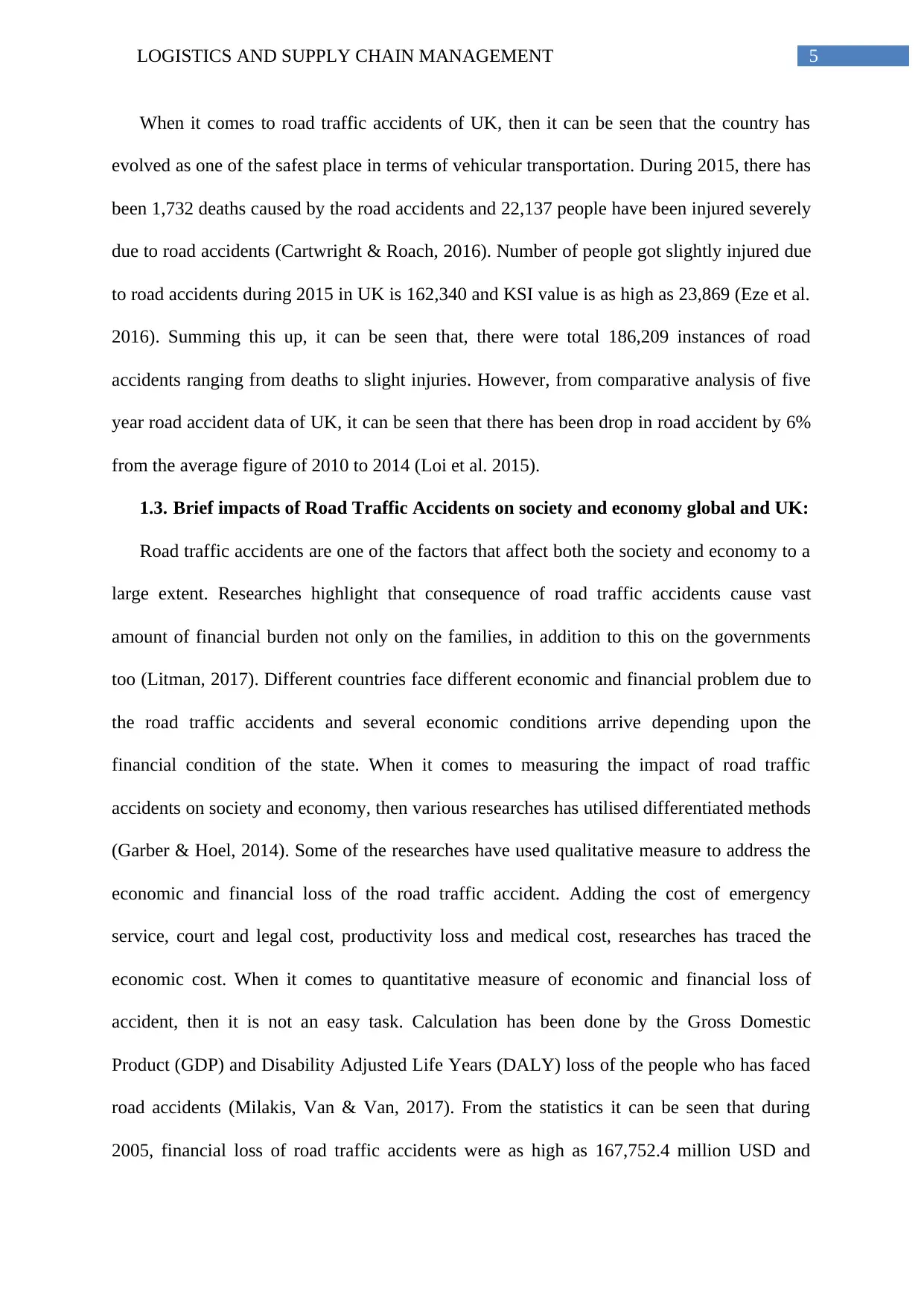
5LOGISTICS AND SUPPLY CHAIN MANAGEMENT
When it comes to road traffic accidents of UK, then it can be seen that the country has
evolved as one of the safest place in terms of vehicular transportation. During 2015, there has
been 1,732 deaths caused by the road accidents and 22,137 people have been injured severely
due to road accidents (Cartwright & Roach, 2016). Number of people got slightly injured due
to road accidents during 2015 in UK is 162,340 and KSI value is as high as 23,869 (Eze et al.
2016). Summing this up, it can be seen that, there were total 186,209 instances of road
accidents ranging from deaths to slight injuries. However, from comparative analysis of five
year road accident data of UK, it can be seen that there has been drop in road accident by 6%
from the average figure of 2010 to 2014 (Loi et al. 2015).
1.3. Brief impacts of Road Traffic Accidents on society and economy global and UK:
Road traffic accidents are one of the factors that affect both the society and economy to a
large extent. Researches highlight that consequence of road traffic accidents cause vast
amount of financial burden not only on the families, in addition to this on the governments
too (Litman, 2017). Different countries face different economic and financial problem due to
the road traffic accidents and several economic conditions arrive depending upon the
financial condition of the state. When it comes to measuring the impact of road traffic
accidents on society and economy, then various researches has utilised differentiated methods
(Garber & Hoel, 2014). Some of the researches have used qualitative measure to address the
economic and financial loss of the road traffic accident. Adding the cost of emergency
service, court and legal cost, productivity loss and medical cost, researches has traced the
economic cost. When it comes to quantitative measure of economic and financial loss of
accident, then it is not an easy task. Calculation has been done by the Gross Domestic
Product (GDP) and Disability Adjusted Life Years (DALY) loss of the people who has faced
road accidents (Milakis, Van & Van, 2017). From the statistics it can be seen that during
2005, financial loss of road traffic accidents were as high as 167,752.4 million USD and
When it comes to road traffic accidents of UK, then it can be seen that the country has
evolved as one of the safest place in terms of vehicular transportation. During 2015, there has
been 1,732 deaths caused by the road accidents and 22,137 people have been injured severely
due to road accidents (Cartwright & Roach, 2016). Number of people got slightly injured due
to road accidents during 2015 in UK is 162,340 and KSI value is as high as 23,869 (Eze et al.
2016). Summing this up, it can be seen that, there were total 186,209 instances of road
accidents ranging from deaths to slight injuries. However, from comparative analysis of five
year road accident data of UK, it can be seen that there has been drop in road accident by 6%
from the average figure of 2010 to 2014 (Loi et al. 2015).
1.3. Brief impacts of Road Traffic Accidents on society and economy global and UK:
Road traffic accidents are one of the factors that affect both the society and economy to a
large extent. Researches highlight that consequence of road traffic accidents cause vast
amount of financial burden not only on the families, in addition to this on the governments
too (Litman, 2017). Different countries face different economic and financial problem due to
the road traffic accidents and several economic conditions arrive depending upon the
financial condition of the state. When it comes to measuring the impact of road traffic
accidents on society and economy, then various researches has utilised differentiated methods
(Garber & Hoel, 2014). Some of the researches have used qualitative measure to address the
economic and financial loss of the road traffic accident. Adding the cost of emergency
service, court and legal cost, productivity loss and medical cost, researches has traced the
economic cost. When it comes to quantitative measure of economic and financial loss of
accident, then it is not an easy task. Calculation has been done by the Gross Domestic
Product (GDP) and Disability Adjusted Life Years (DALY) loss of the people who has faced
road accidents (Milakis, Van & Van, 2017). From the statistics it can be seen that during
2005, financial loss of road traffic accidents were as high as 167,752.4 million USD and
⊘ This is a preview!⊘
Do you want full access?
Subscribe today to unlock all pages.

Trusted by 1+ million students worldwide
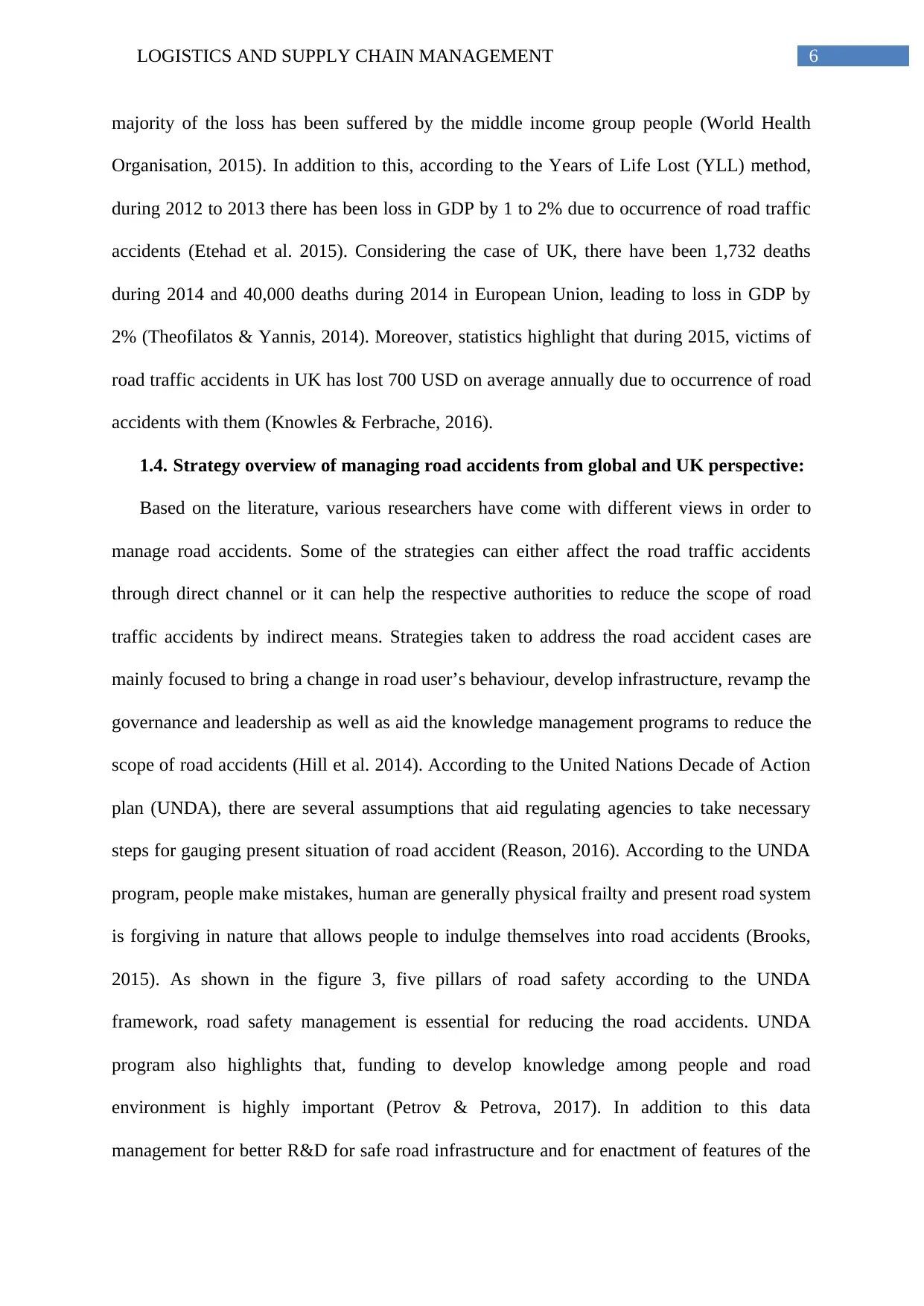
6LOGISTICS AND SUPPLY CHAIN MANAGEMENT
majority of the loss has been suffered by the middle income group people (World Health
Organisation, 2015). In addition to this, according to the Years of Life Lost (YLL) method,
during 2012 to 2013 there has been loss in GDP by 1 to 2% due to occurrence of road traffic
accidents (Etehad et al. 2015). Considering the case of UK, there have been 1,732 deaths
during 2014 and 40,000 deaths during 2014 in European Union, leading to loss in GDP by
2% (Theofilatos & Yannis, 2014). Moreover, statistics highlight that during 2015, victims of
road traffic accidents in UK has lost 700 USD on average annually due to occurrence of road
accidents with them (Knowles & Ferbrache, 2016).
1.4. Strategy overview of managing road accidents from global and UK perspective:
Based on the literature, various researchers have come with different views in order to
manage road accidents. Some of the strategies can either affect the road traffic accidents
through direct channel or it can help the respective authorities to reduce the scope of road
traffic accidents by indirect means. Strategies taken to address the road accident cases are
mainly focused to bring a change in road user’s behaviour, develop infrastructure, revamp the
governance and leadership as well as aid the knowledge management programs to reduce the
scope of road accidents (Hill et al. 2014). According to the United Nations Decade of Action
plan (UNDA), there are several assumptions that aid regulating agencies to take necessary
steps for gauging present situation of road accident (Reason, 2016). According to the UNDA
program, people make mistakes, human are generally physical frailty and present road system
is forgiving in nature that allows people to indulge themselves into road accidents (Brooks,
2015). As shown in the figure 3, five pillars of road safety according to the UNDA
framework, road safety management is essential for reducing the road accidents. UNDA
program also highlights that, funding to develop knowledge among people and road
environment is highly important (Petrov & Petrova, 2017). In addition to this data
management for better R&D for safe road infrastructure and for enactment of features of the
majority of the loss has been suffered by the middle income group people (World Health
Organisation, 2015). In addition to this, according to the Years of Life Lost (YLL) method,
during 2012 to 2013 there has been loss in GDP by 1 to 2% due to occurrence of road traffic
accidents (Etehad et al. 2015). Considering the case of UK, there have been 1,732 deaths
during 2014 and 40,000 deaths during 2014 in European Union, leading to loss in GDP by
2% (Theofilatos & Yannis, 2014). Moreover, statistics highlight that during 2015, victims of
road traffic accidents in UK has lost 700 USD on average annually due to occurrence of road
accidents with them (Knowles & Ferbrache, 2016).
1.4. Strategy overview of managing road accidents from global and UK perspective:
Based on the literature, various researchers have come with different views in order to
manage road accidents. Some of the strategies can either affect the road traffic accidents
through direct channel or it can help the respective authorities to reduce the scope of road
traffic accidents by indirect means. Strategies taken to address the road accident cases are
mainly focused to bring a change in road user’s behaviour, develop infrastructure, revamp the
governance and leadership as well as aid the knowledge management programs to reduce the
scope of road accidents (Hill et al. 2014). According to the United Nations Decade of Action
plan (UNDA), there are several assumptions that aid regulating agencies to take necessary
steps for gauging present situation of road accident (Reason, 2016). According to the UNDA
program, people make mistakes, human are generally physical frailty and present road system
is forgiving in nature that allows people to indulge themselves into road accidents (Brooks,
2015). As shown in the figure 3, five pillars of road safety according to the UNDA
framework, road safety management is essential for reducing the road accidents. UNDA
program also highlights that, funding to develop knowledge among people and road
environment is highly important (Petrov & Petrova, 2017). In addition to this data
management for better R&D for safe road infrastructure and for enactment of features of the
Paraphrase This Document
Need a fresh take? Get an instant paraphrase of this document with our AI Paraphraser
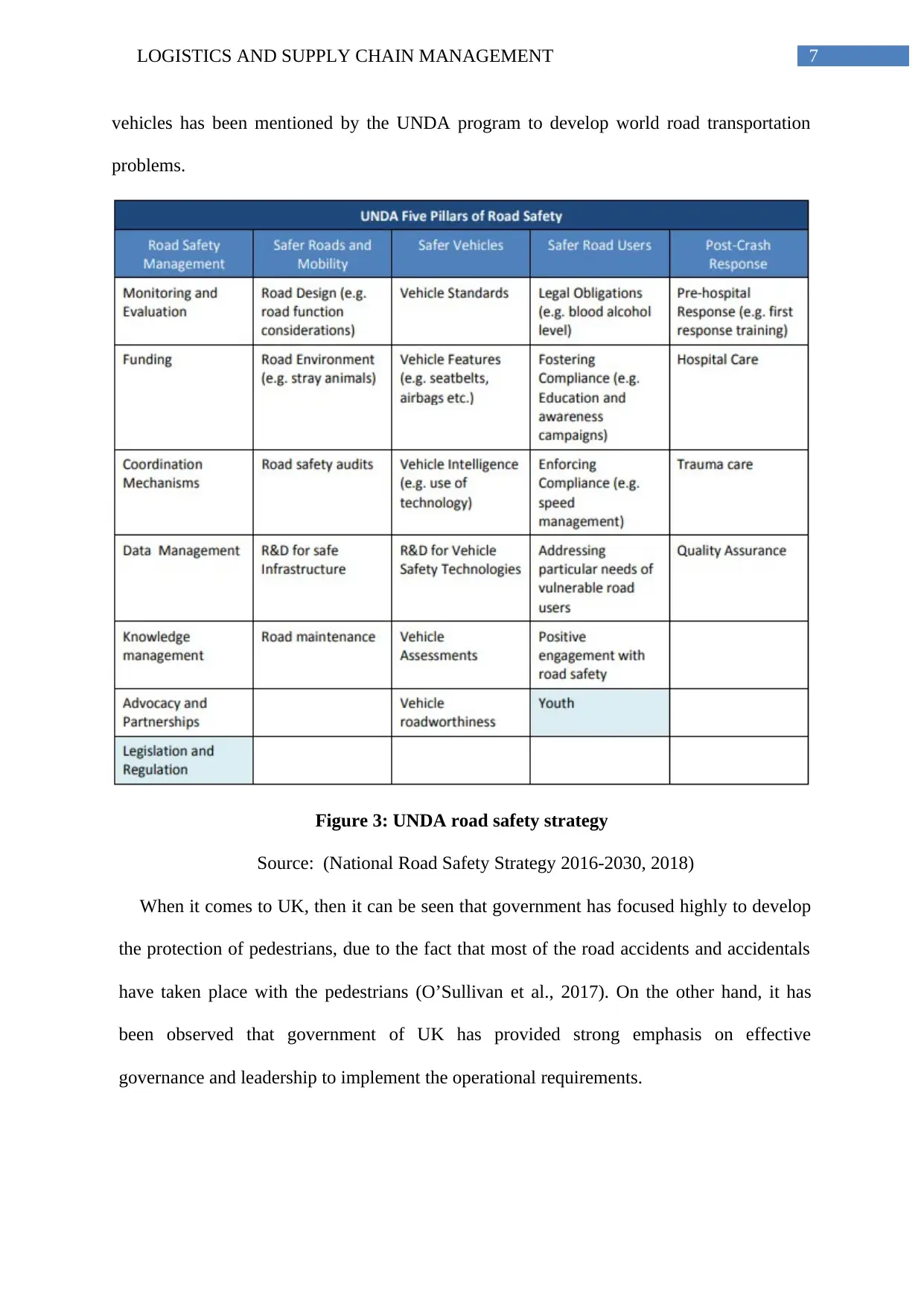
7LOGISTICS AND SUPPLY CHAIN MANAGEMENT
vehicles has been mentioned by the UNDA program to develop world road transportation
problems.
Figure 3: UNDA road safety strategy
Source: (National Road Safety Strategy 2016-2030, 2018)
When it comes to UK, then it can be seen that government has focused highly to develop
the protection of pedestrians, due to the fact that most of the road accidents and accidentals
have taken place with the pedestrians (O’Sullivan et al., 2017). On the other hand, it has
been observed that government of UK has provided strong emphasis on effective
governance and leadership to implement the operational requirements.
vehicles has been mentioned by the UNDA program to develop world road transportation
problems.
Figure 3: UNDA road safety strategy
Source: (National Road Safety Strategy 2016-2030, 2018)
When it comes to UK, then it can be seen that government has focused highly to develop
the protection of pedestrians, due to the fact that most of the road accidents and accidentals
have taken place with the pedestrians (O’Sullivan et al., 2017). On the other hand, it has
been observed that government of UK has provided strong emphasis on effective
governance and leadership to implement the operational requirements.
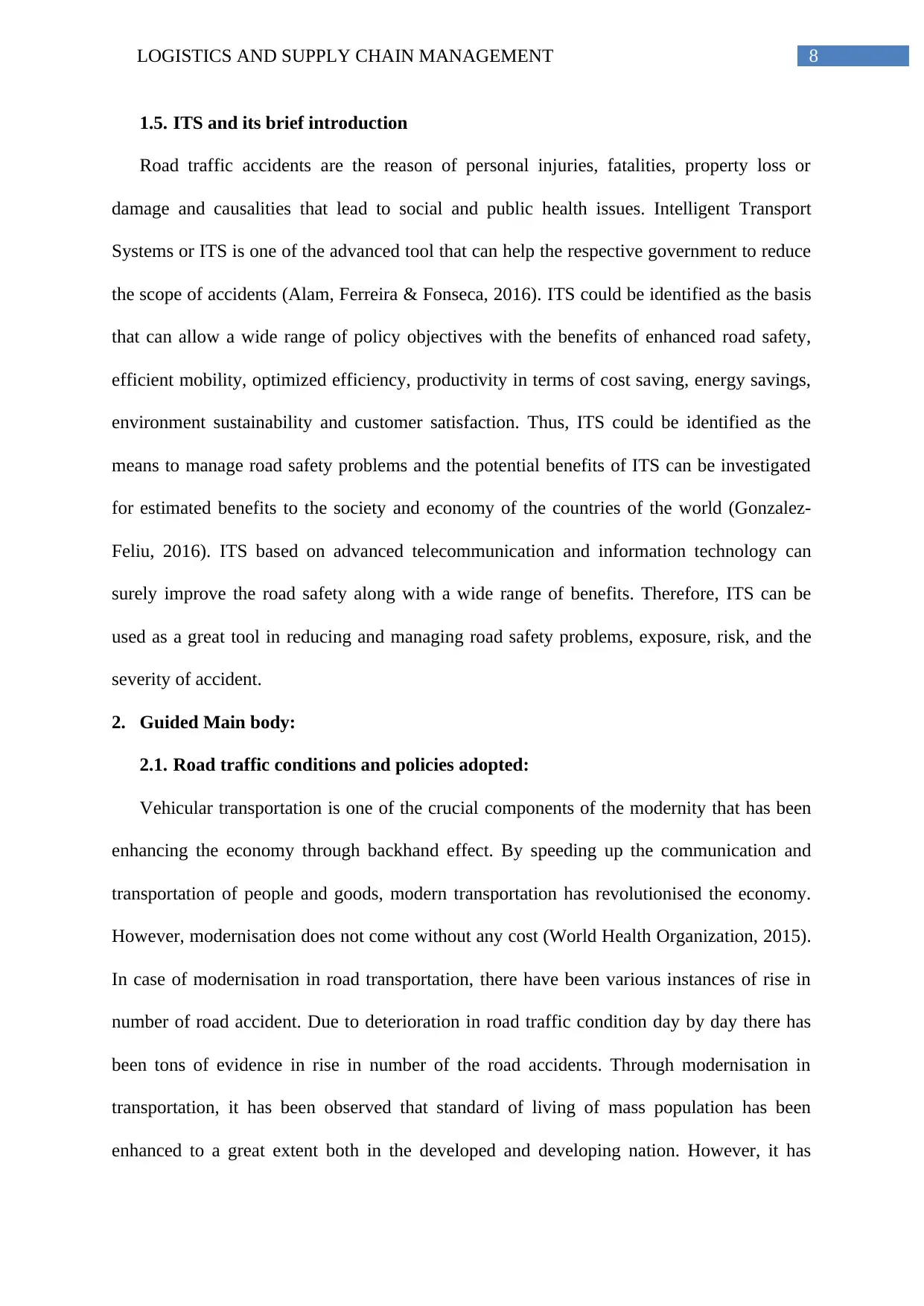
8LOGISTICS AND SUPPLY CHAIN MANAGEMENT
1.5. ITS and its brief introduction
Road traffic accidents are the reason of personal injuries, fatalities, property loss or
damage and causalities that lead to social and public health issues. Intelligent Transport
Systems or ITS is one of the advanced tool that can help the respective government to reduce
the scope of accidents (Alam, Ferreira & Fonseca, 2016). ITS could be identified as the basis
that can allow a wide range of policy objectives with the benefits of enhanced road safety,
efficient mobility, optimized efficiency, productivity in terms of cost saving, energy savings,
environment sustainability and customer satisfaction. Thus, ITS could be identified as the
means to manage road safety problems and the potential benefits of ITS can be investigated
for estimated benefits to the society and economy of the countries of the world (Gonzalez-
Feliu, 2016). ITS based on advanced telecommunication and information technology can
surely improve the road safety along with a wide range of benefits. Therefore, ITS can be
used as a great tool in reducing and managing road safety problems, exposure, risk, and the
severity of accident.
2. Guided Main body:
2.1. Road traffic conditions and policies adopted:
Vehicular transportation is one of the crucial components of the modernity that has been
enhancing the economy through backhand effect. By speeding up the communication and
transportation of people and goods, modern transportation has revolutionised the economy.
However, modernisation does not come without any cost (World Health Organization, 2015).
In case of modernisation in road transportation, there have been various instances of rise in
number of road accident. Due to deterioration in road traffic condition day by day there has
been tons of evidence in rise in number of the road accidents. Through modernisation in
transportation, it has been observed that standard of living of mass population has been
enhanced to a great extent both in the developed and developing nation. However, it has
1.5. ITS and its brief introduction
Road traffic accidents are the reason of personal injuries, fatalities, property loss or
damage and causalities that lead to social and public health issues. Intelligent Transport
Systems or ITS is one of the advanced tool that can help the respective government to reduce
the scope of accidents (Alam, Ferreira & Fonseca, 2016). ITS could be identified as the basis
that can allow a wide range of policy objectives with the benefits of enhanced road safety,
efficient mobility, optimized efficiency, productivity in terms of cost saving, energy savings,
environment sustainability and customer satisfaction. Thus, ITS could be identified as the
means to manage road safety problems and the potential benefits of ITS can be investigated
for estimated benefits to the society and economy of the countries of the world (Gonzalez-
Feliu, 2016). ITS based on advanced telecommunication and information technology can
surely improve the road safety along with a wide range of benefits. Therefore, ITS can be
used as a great tool in reducing and managing road safety problems, exposure, risk, and the
severity of accident.
2. Guided Main body:
2.1. Road traffic conditions and policies adopted:
Vehicular transportation is one of the crucial components of the modernity that has been
enhancing the economy through backhand effect. By speeding up the communication and
transportation of people and goods, modern transportation has revolutionised the economy.
However, modernisation does not come without any cost (World Health Organization, 2015).
In case of modernisation in road transportation, there have been various instances of rise in
number of road accident. Due to deterioration in road traffic condition day by day there has
been tons of evidence in rise in number of the road accidents. Through modernisation in
transportation, it has been observed that standard of living of mass population has been
enhanced to a great extent both in the developed and developing nation. However, it has
⊘ This is a preview!⊘
Do you want full access?
Subscribe today to unlock all pages.

Trusted by 1+ million students worldwide
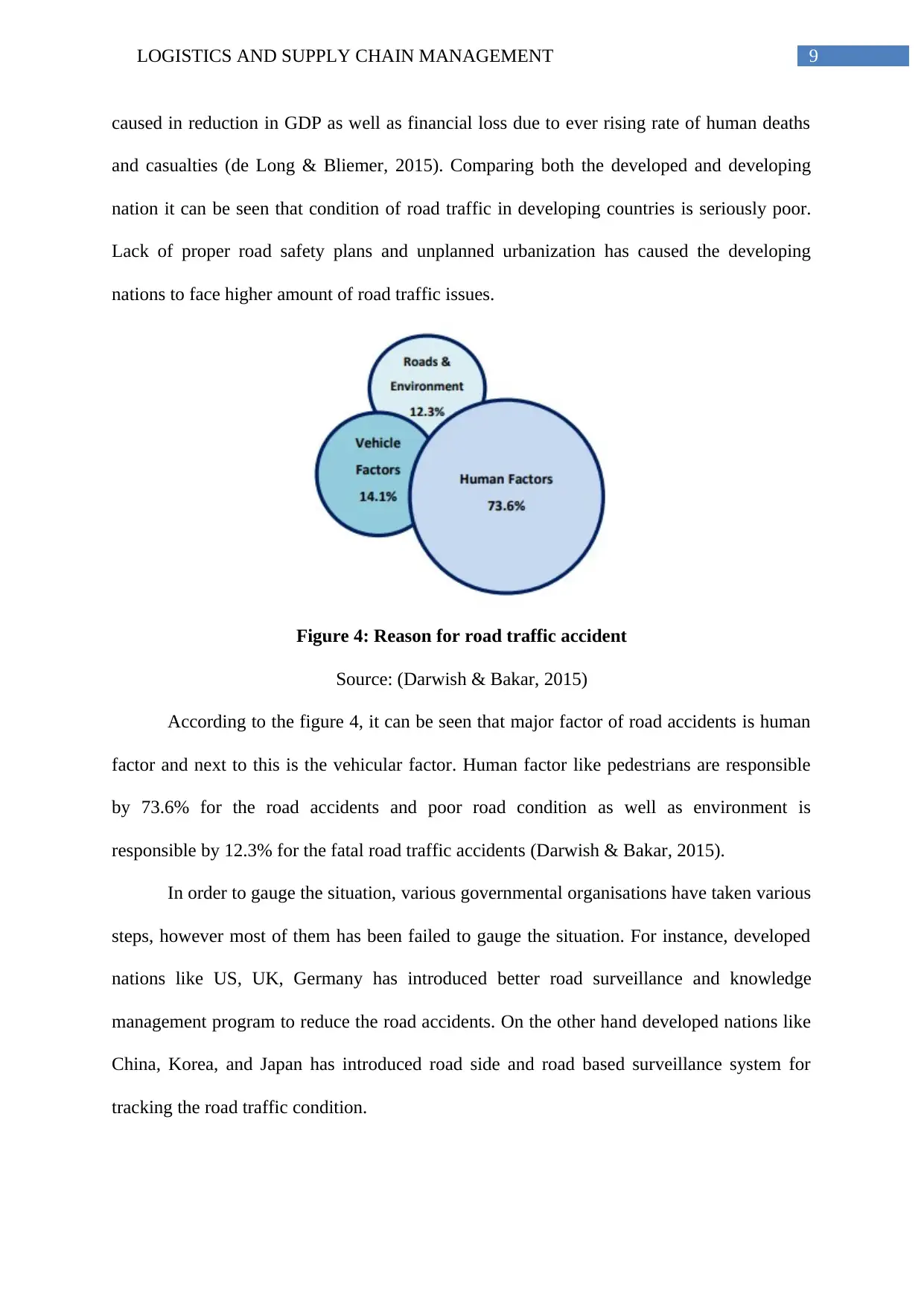
9LOGISTICS AND SUPPLY CHAIN MANAGEMENT
caused in reduction in GDP as well as financial loss due to ever rising rate of human deaths
and casualties (de Long & Bliemer, 2015). Comparing both the developed and developing
nation it can be seen that condition of road traffic in developing countries is seriously poor.
Lack of proper road safety plans and unplanned urbanization has caused the developing
nations to face higher amount of road traffic issues.
Figure 4: Reason for road traffic accident
Source: (Darwish & Bakar, 2015)
According to the figure 4, it can be seen that major factor of road accidents is human
factor and next to this is the vehicular factor. Human factor like pedestrians are responsible
by 73.6% for the road accidents and poor road condition as well as environment is
responsible by 12.3% for the fatal road traffic accidents (Darwish & Bakar, 2015).
In order to gauge the situation, various governmental organisations have taken various
steps, however most of them has been failed to gauge the situation. For instance, developed
nations like US, UK, Germany has introduced better road surveillance and knowledge
management program to reduce the road accidents. On the other hand developed nations like
China, Korea, and Japan has introduced road side and road based surveillance system for
tracking the road traffic condition.
caused in reduction in GDP as well as financial loss due to ever rising rate of human deaths
and casualties (de Long & Bliemer, 2015). Comparing both the developed and developing
nation it can be seen that condition of road traffic in developing countries is seriously poor.
Lack of proper road safety plans and unplanned urbanization has caused the developing
nations to face higher amount of road traffic issues.
Figure 4: Reason for road traffic accident
Source: (Darwish & Bakar, 2015)
According to the figure 4, it can be seen that major factor of road accidents is human
factor and next to this is the vehicular factor. Human factor like pedestrians are responsible
by 73.6% for the road accidents and poor road condition as well as environment is
responsible by 12.3% for the fatal road traffic accidents (Darwish & Bakar, 2015).
In order to gauge the situation, various governmental organisations have taken various
steps, however most of them has been failed to gauge the situation. For instance, developed
nations like US, UK, Germany has introduced better road surveillance and knowledge
management program to reduce the road accidents. On the other hand developed nations like
China, Korea, and Japan has introduced road side and road based surveillance system for
tracking the road traffic condition.
Paraphrase This Document
Need a fresh take? Get an instant paraphrase of this document with our AI Paraphraser
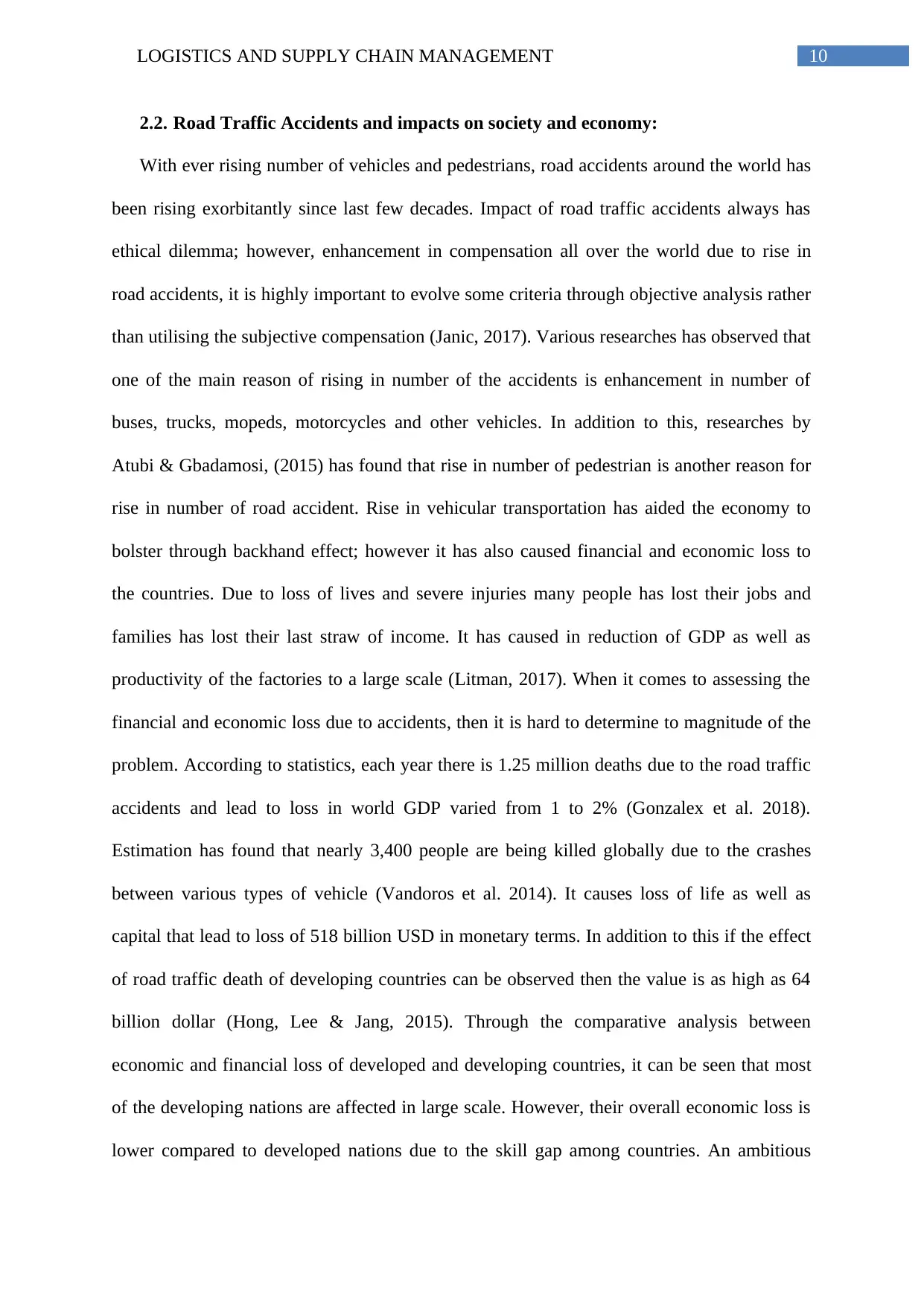
10LOGISTICS AND SUPPLY CHAIN MANAGEMENT
2.2. Road Traffic Accidents and impacts on society and economy:
With ever rising number of vehicles and pedestrians, road accidents around the world has
been rising exorbitantly since last few decades. Impact of road traffic accidents always has
ethical dilemma; however, enhancement in compensation all over the world due to rise in
road accidents, it is highly important to evolve some criteria through objective analysis rather
than utilising the subjective compensation (Janic, 2017). Various researches has observed that
one of the main reason of rising in number of the accidents is enhancement in number of
buses, trucks, mopeds, motorcycles and other vehicles. In addition to this, researches by
Atubi & Gbadamosi, (2015) has found that rise in number of pedestrian is another reason for
rise in number of road accident. Rise in vehicular transportation has aided the economy to
bolster through backhand effect; however it has also caused financial and economic loss to
the countries. Due to loss of lives and severe injuries many people has lost their jobs and
families has lost their last straw of income. It has caused in reduction of GDP as well as
productivity of the factories to a large scale (Litman, 2017). When it comes to assessing the
financial and economic loss due to accidents, then it is hard to determine to magnitude of the
problem. According to statistics, each year there is 1.25 million deaths due to the road traffic
accidents and lead to loss in world GDP varied from 1 to 2% (Gonzalex et al. 2018).
Estimation has found that nearly 3,400 people are being killed globally due to the crashes
between various types of vehicle (Vandoros et al. 2014). It causes loss of life as well as
capital that lead to loss of 518 billion USD in monetary terms. In addition to this if the effect
of road traffic death of developing countries can be observed then the value is as high as 64
billion dollar (Hong, Lee & Jang, 2015). Through the comparative analysis between
economic and financial loss of developed and developing countries, it can be seen that most
of the developing nations are affected in large scale. However, their overall economic loss is
lower compared to developed nations due to the skill gap among countries. An ambitious
2.2. Road Traffic Accidents and impacts on society and economy:
With ever rising number of vehicles and pedestrians, road accidents around the world has
been rising exorbitantly since last few decades. Impact of road traffic accidents always has
ethical dilemma; however, enhancement in compensation all over the world due to rise in
road accidents, it is highly important to evolve some criteria through objective analysis rather
than utilising the subjective compensation (Janic, 2017). Various researches has observed that
one of the main reason of rising in number of the accidents is enhancement in number of
buses, trucks, mopeds, motorcycles and other vehicles. In addition to this, researches by
Atubi & Gbadamosi, (2015) has found that rise in number of pedestrian is another reason for
rise in number of road accident. Rise in vehicular transportation has aided the economy to
bolster through backhand effect; however it has also caused financial and economic loss to
the countries. Due to loss of lives and severe injuries many people has lost their jobs and
families has lost their last straw of income. It has caused in reduction of GDP as well as
productivity of the factories to a large scale (Litman, 2017). When it comes to assessing the
financial and economic loss due to accidents, then it is hard to determine to magnitude of the
problem. According to statistics, each year there is 1.25 million deaths due to the road traffic
accidents and lead to loss in world GDP varied from 1 to 2% (Gonzalex et al. 2018).
Estimation has found that nearly 3,400 people are being killed globally due to the crashes
between various types of vehicle (Vandoros et al. 2014). It causes loss of life as well as
capital that lead to loss of 518 billion USD in monetary terms. In addition to this if the effect
of road traffic death of developing countries can be observed then the value is as high as 64
billion dollar (Hong, Lee & Jang, 2015). Through the comparative analysis between
economic and financial loss of developed and developing countries, it can be seen that most
of the developing nations are affected in large scale. However, their overall economic loss is
lower compared to developed nations due to the skill gap among countries. An ambitious
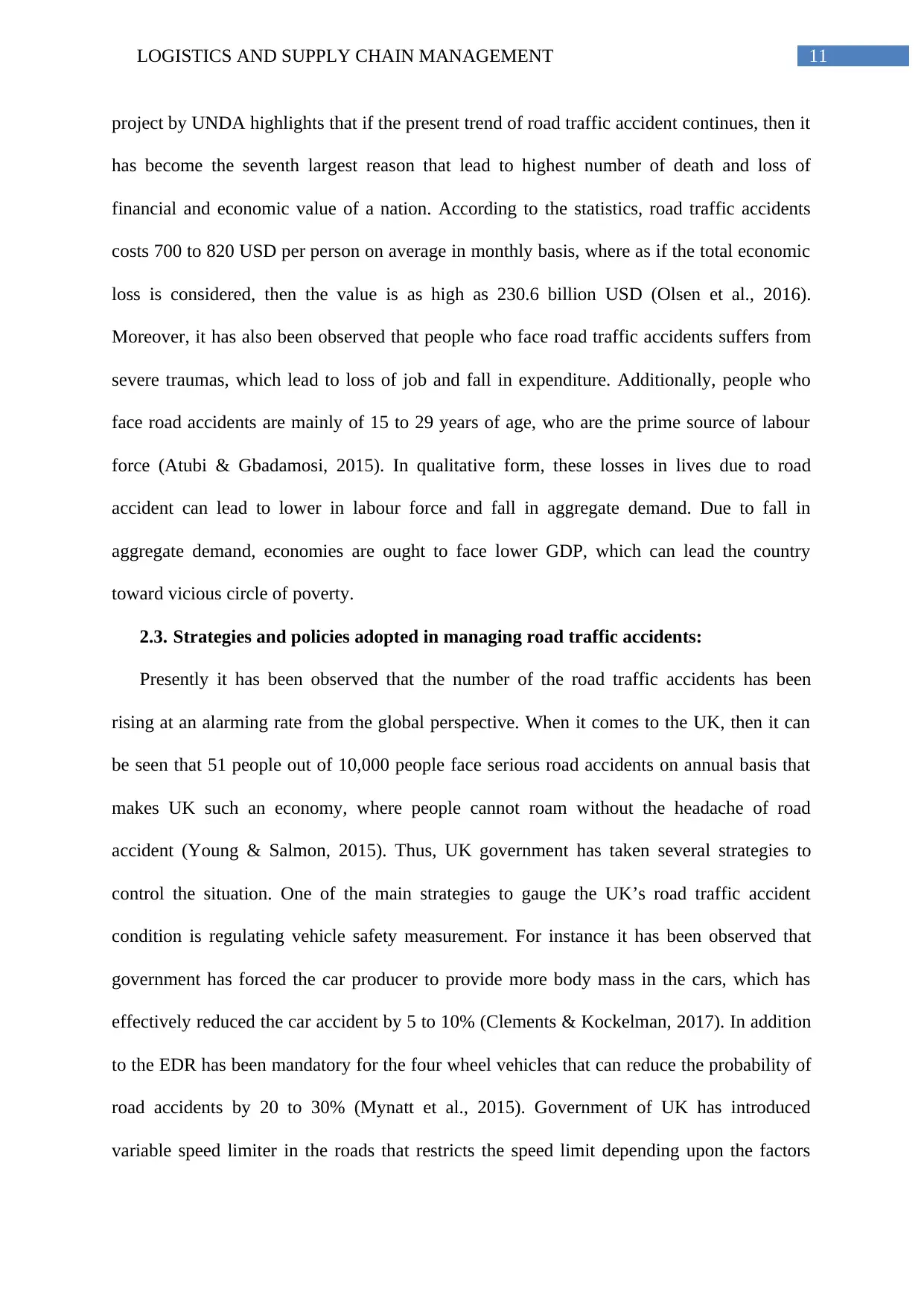
11LOGISTICS AND SUPPLY CHAIN MANAGEMENT
project by UNDA highlights that if the present trend of road traffic accident continues, then it
has become the seventh largest reason that lead to highest number of death and loss of
financial and economic value of a nation. According to the statistics, road traffic accidents
costs 700 to 820 USD per person on average in monthly basis, where as if the total economic
loss is considered, then the value is as high as 230.6 billion USD (Olsen et al., 2016).
Moreover, it has also been observed that people who face road traffic accidents suffers from
severe traumas, which lead to loss of job and fall in expenditure. Additionally, people who
face road accidents are mainly of 15 to 29 years of age, who are the prime source of labour
force (Atubi & Gbadamosi, 2015). In qualitative form, these losses in lives due to road
accident can lead to lower in labour force and fall in aggregate demand. Due to fall in
aggregate demand, economies are ought to face lower GDP, which can lead the country
toward vicious circle of poverty.
2.3. Strategies and policies adopted in managing road traffic accidents:
Presently it has been observed that the number of the road traffic accidents has been
rising at an alarming rate from the global perspective. When it comes to the UK, then it can
be seen that 51 people out of 10,000 people face serious road accidents on annual basis that
makes UK such an economy, where people cannot roam without the headache of road
accident (Young & Salmon, 2015). Thus, UK government has taken several strategies to
control the situation. One of the main strategies to gauge the UK’s road traffic accident
condition is regulating vehicle safety measurement. For instance it has been observed that
government has forced the car producer to provide more body mass in the cars, which has
effectively reduced the car accident by 5 to 10% (Clements & Kockelman, 2017). In addition
to the EDR has been mandatory for the four wheel vehicles that can reduce the probability of
road accidents by 20 to 30% (Mynatt et al., 2015). Government of UK has introduced
variable speed limiter in the roads that restricts the speed limit depending upon the factors
project by UNDA highlights that if the present trend of road traffic accident continues, then it
has become the seventh largest reason that lead to highest number of death and loss of
financial and economic value of a nation. According to the statistics, road traffic accidents
costs 700 to 820 USD per person on average in monthly basis, where as if the total economic
loss is considered, then the value is as high as 230.6 billion USD (Olsen et al., 2016).
Moreover, it has also been observed that people who face road traffic accidents suffers from
severe traumas, which lead to loss of job and fall in expenditure. Additionally, people who
face road accidents are mainly of 15 to 29 years of age, who are the prime source of labour
force (Atubi & Gbadamosi, 2015). In qualitative form, these losses in lives due to road
accident can lead to lower in labour force and fall in aggregate demand. Due to fall in
aggregate demand, economies are ought to face lower GDP, which can lead the country
toward vicious circle of poverty.
2.3. Strategies and policies adopted in managing road traffic accidents:
Presently it has been observed that the number of the road traffic accidents has been
rising at an alarming rate from the global perspective. When it comes to the UK, then it can
be seen that 51 people out of 10,000 people face serious road accidents on annual basis that
makes UK such an economy, where people cannot roam without the headache of road
accident (Young & Salmon, 2015). Thus, UK government has taken several strategies to
control the situation. One of the main strategies to gauge the UK’s road traffic accident
condition is regulating vehicle safety measurement. For instance it has been observed that
government has forced the car producer to provide more body mass in the cars, which has
effectively reduced the car accident by 5 to 10% (Clements & Kockelman, 2017). In addition
to the EDR has been mandatory for the four wheel vehicles that can reduce the probability of
road accidents by 20 to 30% (Mynatt et al., 2015). Government of UK has introduced
variable speed limiter in the roads that restricts the speed limit depending upon the factors
⊘ This is a preview!⊘
Do you want full access?
Subscribe today to unlock all pages.

Trusted by 1+ million students worldwide
1 out of 45
Related Documents
Your All-in-One AI-Powered Toolkit for Academic Success.
+13062052269
info@desklib.com
Available 24*7 on WhatsApp / Email
![[object Object]](/_next/static/media/star-bottom.7253800d.svg)
Unlock your academic potential
Copyright © 2020–2025 A2Z Services. All Rights Reserved. Developed and managed by ZUCOL.





